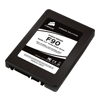- Qualcomm Launches Snapdragon 4 Gen 2 Mobile Platform
- AMD Launches Ryzen PRO 7000 Series Mobile & Desktop Platform
- Intel Launches Sleek Single-Slot Arc Pro A60 Workstation Graphics Card
- NVIDIA Announces Latest Ada Lovelace Additions: GeForce RTX 4060 Ti & RTX 4060
- Maxon Redshift With AMD Radeon GPU Rendering Support Now Available
Corsair Force F90 90GB Solid-State Drive Review

There couldn’t be a better time than the present to purchase an SSD, and on the same token, it’s also a strange time. Performance drives cost the same as budget drives, and a perfect example of this is Corsair’s Force F90. It’s priced-right, offers incredible performance, and makes perfect use of its SandForce SF-1200 controller.
Page 10 – 34nm vs. 25nm NAND Flash
Amongst consumers there is a fair amount of negativity being perpetuated regarding 25nm NAND. While it is true the NAND cells have a lower erase cycle endurance as opposed to 34nm NAND, it needs to be mentioned that these drives are over-provisioned with additional NAND capacity specifically to offset this problem. Mechanical hard drives have done this for decades; if a sector became unusable they would simply allocate a sector from the hidden spare area portion of the drive.
This leaves only the question of longevity… how long is long, exactly? The longevity of solid-state drives has long been one of the largest sticking points with consumers. (That pun is getting long in the tooth). It is one thing to pay a price premium for a product that would significantly outlast its cheap competitor, but with SSDs it was oft regarded that they wouldn’t last even as long as a hard drive. Let us put this one to rest. It has been indicated that 25nm NAND will offer somewhere between 3,000-5,000 write-erase cycles. 34nm NAND specifications indicated a minimum of 5,000 cycles, but until whitepapers are published let’s assume 3,000 is the new number.
The average person will write somewhere between 2-5GB a day as a rough estimate. Most often it is less, but let us almost double that to 9GB a day. Assuming we buy a 90GB Corsair Force drive, it would take 10 days to fill the drive with data. Once filled, that means we have used 1 erase cycle to clear the drive and start anew. Keep in mind intelligent wear leveling will ensure all writes get evenly distributed across a drive over its lifespan. Ten days multiplied by 3,000 write-erase cycles equates into roughly 82 years before we would exhaust every last cell’s write-erase cycle. NAND flash will actually lose its charge after 10 years of age by comparison.
Admittedly things aren’t that simple thanks to how NAND memory is structured. To write something it occurs at the 4KB or 8KB size, what we call a page (instead of a sector on a HDD). But in order for us to erase the data in a single page, the drive must erase an entire block of pages that one page resides on. SSD’s can write to individual pages, but only erase at the block level. All SSDs do this regularly during operation all without notice by the user. This effect is known as write amplification. For the best drives this number should be as close to 1 as possible, but let’s assume 10 as a worst case scenario.
Instead of:
9GB / 90GB = 10 days. 10 * 3,000 cycles is 30,000 days, or 82 years
We get:
(9GB*10) = 90GB written a day. 90/90GB = 1 cycle a day. 1*3,000 cycles is 8.2 years.
Or take our first number and divide by 10, although we imagine realizing the controller itself could write 90GB of data a day (at the NAND/controller level) and still have the drive easily outlast its warranty period should help the idea sink in a bit. Oh, and we should mention the 34nm model 90GB Force drive has 96GB of NAND on board, we didn’t factor that extra 6GB of spare area into our above calculations.
Good quality controllers are required, (not all controllers are created equal), but otherwise solid-state drives should enjoy a lifespan well above that three year warranty period, and potentially well above that of most mechanical hard drives in the process. If the SSD did break, it at least shouldn’t be from the NAND wearing out. Of course, given the sharp decline at which fabrication size decreases write/erase cycles, we suspect the next process shrink from 25nm the next smaller node may require either new technological advances in NAND fabrication or some ingenious solutions. But until then I personally no longer have any qualm with using a 25nm NAND drive. And for those that still do, Corsair has made a clear distinction on which Force drives feature which NAND, something we like to applaud the company for.
Support our efforts! With ad revenue at an all-time low for written websites, we're relying more than ever on reader support to help us continue putting so much effort into this type of content. You can support us by becoming a Patron, or by using our Amazon shopping affiliate links listed through our articles. Thanks for your support!




